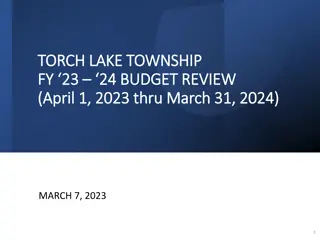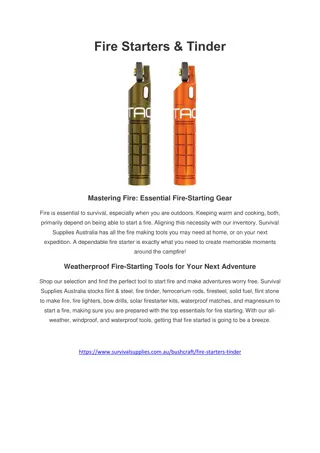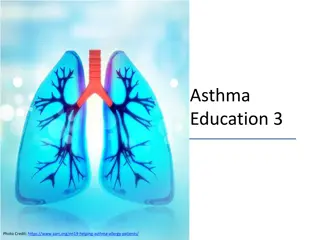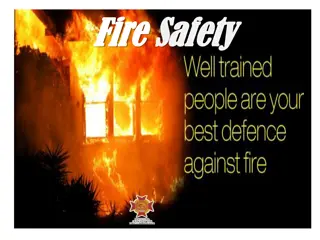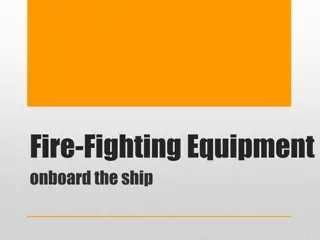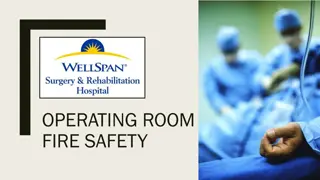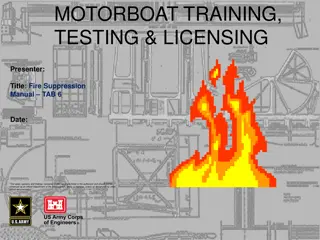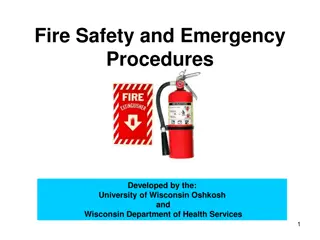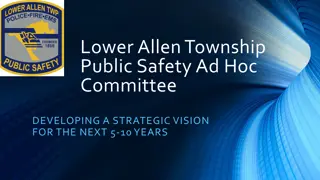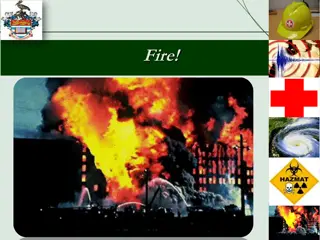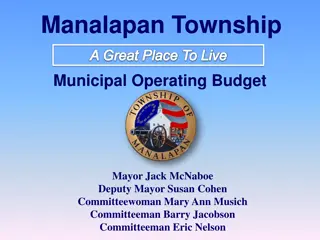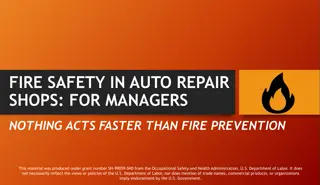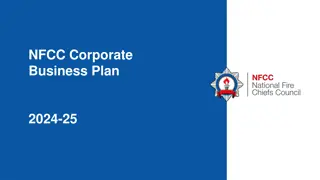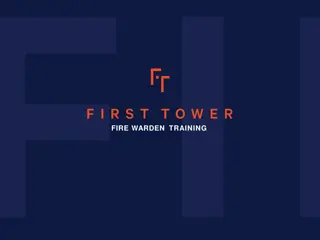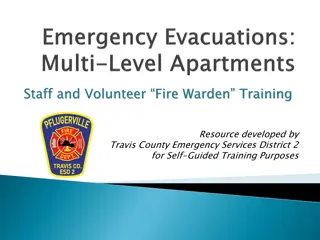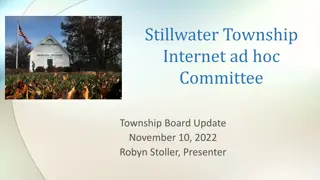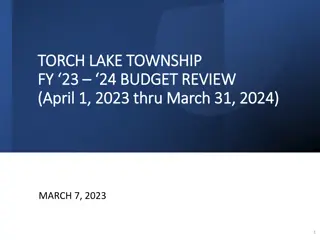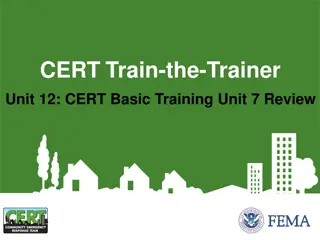Lower Allen Township Public Safety Ad Hoc Committee Fire/Rescue Services Presentation
The Lower Allen Township Public Safety Ad Hoc Committee organized a Fire/Rescue Services Presentation featuring presenters from Lower Allen Fire Company, Lisburn Community Fire Company, and Lower Allen Dept. of Public Safety. The presentation focused on identifying capability gaps, preparing for different service levels, and measuring performance objectives. Discussions included the needed personnel, equipment, and capabilities for offensive service levels with expectations of efficient fire extinguishing, life-saving, vehicle rescue, and hazardous materials response. The event also included a schedule for tours and programs related to public safety.
Download Presentation

Please find below an Image/Link to download the presentation.
The content on the website is provided AS IS for your information and personal use only. It may not be sold, licensed, or shared on other websites without obtaining consent from the author. Download presentation by click this link. If you encounter any issues during the download, it is possible that the publisher has removed the file from their server.
E N D
Presentation Transcript
Lower Allen Township Public Safety Ad Hoc Committee FIRE/RESCUE SERVICES PRESENTATION
Fire/Rescue Service Presenters LOWER ALLEN FIRE COMPANY NO. 1 FIRE CHIEF DAVID MURDOCH LISBURN COMMUNITY FIRE COMPANY FIRE CHIEF FRANK WILLIAMSON JR. LOWER ALLEN DEPT. OF PUBLIC SAFETY FIRE CAPTAIN FRANK WIRTH JR.
Fire/Rescue Service Presentation Schedule June 4, 2019 Tour of Fire Station # 2 What gaps exist between the capabilities we need and the capabilities we currently have? How can we address our capability gaps? June 18, 2019 Cedar Cliff High School Public Safety Officer Program
The Questions What do we need to prepare for? What level of capability do we need to be prepared for? What are our current capabilities? What gaps exist between the capabilities we need and the capabilities we currently have? How can we address our capability gaps?
Previous Presentation Performance Objectives and Measurements Levels of service
What level of capability do we need to be prepared for? Offensive Service Level 1 Personnel Required -15 Equipment -2 NFPA criteria engine (pumper), and one truck company (aerial or support truck) Interior and Exterior Firefighting capabilities of both residential and commercial buildings. Vehicle rescue capabilities with power or no power equipment and provide Operations level Hazardous Materials Response. NFPA PPE/SCBA for each person. Expectations -Ability to extinguish a fire and save life and property. The ability to perform and extricate a person from a motor vehicle efficiently. The ability to identify and provide operations level hazardous materials response. Arrive on scene within 9 minutes of dispatch, 90 percent of the time.
What level of capability do we need to be prepared for? Offensive Service Level 2 Personnel required - 10 Equipment -2 NFPA criteria engine (pumper) Interior Firefighting capabilities of room or contents and small buildings under 10,000 square feet. Vehicle rescue capabilities with power or no power equipment and provide Operations level Hazardous Materials Response. NFPA PPE/SCBA. Expectations -Ability to extinguish a fire and save life and property. The ability to perform and extricate a person from a motor vehicle efficiently. The ability to identify and provide operations level hazardous materials response. Arrive on scene within 10 minutes of dispatch, 80 percent of the time.
What level of capability do we need to be prepared for? Offensive Service Level 3 Personnel required 6 Equipment -l NFPA criteria engine (pumper) c. Interior Firefighting capabilities only of room or contents and small buildings under 5,000 square feet. Also, vehicle extrication capabilities with little or no power equipment. NFPA PPE/SCBA. Expectations -Ability to extinguish a fire and save life and property. The ability to extricate a person from a motor vehicle efficiently. Respond within 9 minutes, plus travel time.
What level of capability do we need to be prepared for? Offensive Service Level 4 Personnel required 4 Equipment -l NFPA criteria engine (pumper) Exterior Defensive Firefighting capabilities only Expectations Protect surrounding exposures, loss of involved property NO TIME LIMITS
What gaps exist between the capabilities we need and the capabilities we currently have? Staffing drives everything
What gaps exist between the capabilities we need and the capabilities we currently have? Vacation Staffing Many demands placed on people today? Two, Three, sometimes Four income families Time is worth more than money in most cases. Sports Work
What gaps exist between the capabilities we need and the capabilities we currently have? Qualified Firefighters Basic Training needed (186 hours) Initial LAFD Training 8-10 hours Essentials of Firefighting 140 hours Hazardous Materials Operations Level 24 hours Incident Command Systems 12 hours Specialized Training Basic Vehicle Rescue 44 hours Engine Company Ops 23 hours Truck Company Ops 32 hours Technical Rescue 48 hours
Pennsylvania Firefighter Census 350,000 300,000 300,000 250,000 200,000 150,000 150,000 100,000 75,000 50,000 38,000 50,000 0 1975 1990 2000 2010 2018
Lower Allen Fire Co - Calls & Staffing per year 900 35 What are our current capabilities? 800 30 700 25 600 20 500 400 15 300 10 200 5 100 0 0 1996 1997 1998 1999 2000 2001 2002 2003 2004 2005 2006 2007 2008 2009 2010 2011 2012 2013 2014 2015 2016 2017 2018 Total Calls # FF > 50% Volunteers & PSOs >10% Volunteers > 10%
Lisburn Fire Co Calls and Staffing per Year 250 16 What are our current capabilities? 14 200 12 10 150 8 100 6 4 50 2 0 0 2006 2007 2008 2009 2010 2011 2012 2013 2014 2015 2016 2017 2018 Total Calls # FF > 50% # FF > 25% # Vol FF > 25% # FF > 10% # Vol FF > 10%
Lower Allen Fire Day / Night Average Staffing Responders on Scene What are our current capabilities? 5.4 5.4 5.2 4.6 4.3 3.6 2017 2018 2019 DAY NIGHT
What gaps exist between the capabilities we need and the capabilities we currently have? Volunteer fire service model is changing High turnover Generational Issues Fewer people volunteering Competitive job market not as much time to volunteer Challenges in filling public safety positions (Police, Fire, and EMS) Younger generation more apt to move job to job Not looking at long term careers No immediate reward
What gaps exist between the capabilities we need and the capabilities we currently have? Volunteer fire service model is changing Addition of incentive programs Gift cards Logo wear/clothing Banquet Fire Company parties Pay per call Live-in programs (Lower Allen Fire currently has one) Jr. Firefighter programs (both Lisburn and Lower Allen Fire companies have one)
What gaps exist between the capabilities we need and the capabilities we currently have? Lower Allen Model Three legged stool (Live-Ins, Volunteers, PSOs)
What gaps exist between the capabilities we need and the capabilities we currently have? Lisburn Model foundation is based on volunteers with assistance from Lower Allen Public Safety Officers.
What gaps exist between the capabilities we need and the capabilities we currently have? Staffing of Volunteer Fire Department/Non-Profit Organization (501c3) Administrative responsibilities Federal, State, and Local Laws, Rules, and Regulations Educated decision making (Business sense) Proper safe-guarding of assets Fire and EMS Administrative Officer Course (DCED and PSFA) Financial component requires qualified personnel Human Resources issues Management of volunteers vs. paid staff Will Volunteer Non-Profits (Fire Companies) exist in the future? Many non-profits have paid positions Current LAFC Business Administrator/Engineer has stepped down and several volunteers have had to fill the gap.
What gaps exist between the capabilities we need and the capabilities we currently have? Cost of PPE Helmet - $390 Return on investment Will they stay? Hood - $100 10 year service life Coat - $2034 Gloves - $125 SCBA - $5796 Pants - $1890 On fire apparatus Boots - $449 46 at Lower Allen Fire 12 at Lisburn Fire TOTAL - $4808
What gaps exist between the capabilities we need and the capabilities we currently have? Finances Fundraising Labor Intensive Return on Investment? Chicken BBQ Sales ($4.40 profit/chicken half) Grants Grant-Writing and Closeouts Municipal Funding Purchase Orders Firemen s Relief Audits
What gaps exist between the capabilities we need and the capabilities we currently have? Apparatus Chief 12 concept of apparatus replacement master plan. Schedule of replacement changed due to decline in economy over past years. 1990 had a replacement plan where all apparatus except Tower Truck (15 year) were replaced at 10 years old. Ideal age for maximum resale value. 4 Engines, Truck, Squad (now called Rescue) Current budget forecasting apparatus replacement plan Apparatus budgeted for 20-25 years old NFPA 1911 Annex D Apparatus > 25 years should be retired from service. Not even reserve. Appendix D.1 highlights the point that fire service leaders should carefully consider the risks to their firefighters of keeping fire apparatus in first-line service when it s more than 15 years old. Very low resale value Higher reoccurring maintenance as units age. Not meeting current functionality, response area & future needs.
What gaps exist between the capabilities we need and the capabilities we currently have? Apparatus Chief 12 concept of apparatus replacement master plan. Going forward; 10-15 year replacement schedule. For Lower Allen Fire Co migrating from 5 frontline apparatus today to 4, by 2025. Future apparatus will all be multi-function. Approx. 25% less cost over all, with a mutli-function apparatus vs 2 single function apparatus. Less reoccurring maintenance cost with less vehicles to maintain. Have to consider higher GPM pumps to meet Township ISO GPM ratings. Less staff to operate 5 apparatus regularly. Future estimate township would not be in a position to fund paid staff for 5 frontline apparatus. Better meeting Township response area needs.
What gaps exist between the capabilities we need and the capabilities we currently have? Apparatus Chief 12 concept of apparatus replacement master plan. Funding replacement plan More accurately forecasting future costs of apparatus. Develop budget revenue plan now to support future costs. Explore leasing options. 8-10 year leases. Spread payments out more smoothly over years vs spike in some years for apparatus purchases.
What gaps exist between the capabilities we need and the capabilities we currently have? Fire Stations Centralized Decentralized Older Stations vs. Newer Stations Location in relationship to political boundaries Lower Allen Fire Company Lisburn Community Fire Company Stations and Apparatus are connected by the needs in their area
Engine Company Locations 1.5 mile radius
Truck Company Locations 2.5 mile radius
What gaps exist between the capabilities we need and the capabilities we currently have? Training Facilities/Areas Distance to Training Facilities HACC Shumaker Public Safety Center North of Main Campus Cumberland County Fire Training Center Carlisle York County Fire School Manchester Township Lancaster County Public Safety Training Center Manheim Areas used for training are becoming more scarce. Pump Operations/Hoseline Operations Limited size of area Traffic Availability of a Water Source (Hydrant) MS4 requirements
What gaps exist between the capabilities we need and the capabilities we currently have? Automatic Aid and Mutual Aid Automatic Aid Assistance from another fire department is automatically dispatched at the time of initial dispatch. Mutual Aid Assistance from another fire department is requested as needed during an incident. Some are formally executed with a written agreement, but the majority are not.
What gaps exist between the capabilities we need and the capabilities we currently have? Automatic Aid and Mutual Aid Key component of response planning Has been used for decades to provided the needed resources for incidents of a challenging nature. High hazard, High Life Hazard, Large facilities, Complex incidents But not the magic wand. Automatic Aid and Mutual Aid is being stretched to its limitations and is at tipping point. The farther the automatic/mutual aid the lower the response times. In some cases Automatic Aid and Mutual Aid may not be available. Federal Fire Departments are used, but could be unavailable at anytime.
What gaps exist between the capabilities we need and the capabilities we currently have? Community Risk Reduction The Five E s Education Public Fire and Life Safety Education Engineering Fire Suppression Systems, Building Compartmentation Enforcement Fire Prevention and Inspections (Intl. Fire Code and Intl. Property Maintenance Code) Economic Incentives Fines for Violations, Reduction of building spacing for fire protection features Emergency Response
What gaps exist between the capabilities we need and the capabilities we currently have? Fire Prevention Inspections and Code Enforcement International Fire Code International Property Maintenance Code Comprehensive planning/zoning and land development) Residential sprinklers Local apartment buildings not sprinklered Mallard Run What are our needs for Fire Protection Risks and Hazards in Lower Allen Township Current What is possible in the future? (Facilities, Businesses, Development)
How can we address our capability gaps? Possible Solutions from the past Intergovernmental cooperation SAFER Grant with Harrisburg City Fire. Strike Engine on West Shore (Problems in agreement on cost sharing and coordination of supervision) Part-Time Driver/Operators in other FDs and municipalities coordinated effort. Dave Murdoch. (Possible but not enough qualified individuals to cover area) (Studied by regional committee and with no agreement and commitment in the end). Other municipalities and organizations are not ready to partner or relinquish power to move the fire service to next level. Boils down to commitment and cost sharing they re just talking at this time. But we should be ready to explore future initiatives.
How can we address our capability gaps? Possible Solutions Future change needs to be an organized and smooth transition to the new model in the future. New model is the one based on the recommendations of the AdHoc Committee and/or Subject Matter Experts Lower Allen Fire and Lisburn Fire Alliance Operationally Policies and Procedures Training Qualifications Firefighter Driver/Operator Fire Officer
How can we address our capability gaps? Possible Solutions Fire Service Models from other communities York Area United Fire Rescue Combination Primarily Career Blue Rock Fire Rescue Volunteer with career staff support Manheim Township Fire Rescue In Transition from Volunteer to Combination State College COG Volunteer with career staff support Public Safety Officers (evolution from LE centric to Fire/EMS centric) Accreditation Center for Public Safety Excellence (CPSE) Standard of Cover Community Risk Assessment Emergency Response Deployment Plan Strategic Plan Self-Assessment
What Challenges/Barriers do we face? What is driving volunteers away? Moved Away 58% Job Commitments 52% Family Commitments 44% Lack of Interest 35% Personality Conflicts 34% School/College 30% Disagreement with Leadership 22% Retirement/Old Age 21% Expulsion 17% Disliked Training 13% Illness/Disability 11% 2012 Study on Recruitment and Retention of Firefighters from The Center for Rural Pennsylvania Totals do not add up to 100 % due to multiple responses
What Challenges/Barriers do we face? Challenges/Barriers Fundraising Too Many Fundraisers Are Negatively Affecting Firefighter Retention Only one variable was correlated with the number of fundraising events retention. The number of fundraising events was not correlated with the size of the fire company, the number of firefighters, the number of new firefighters, or the net change in firefighters. So, it appears that the more fundraising events the company sponsored the more firefighters that left the company or became inactive. This finding could suggest that many fundraising events may contribute to the loss of firefighters; but it does not necessarily deter new firefighters from joining. 2012 Study on Recruitment and Retention of Firefighters from The Center for Rural Pennsylvania
What Challenges/Barriers do we face? Challenges/Barriers Fundraising What does it truly cost to raise money? Maintenance of equipment and facilities Utilities Effective use of Human Resources (People) Previous example of Chicken BBQ at Lisburn Fire Company with $4.40 profit. 113,636 chicken halves would need to be sold to purchase a $500,000 Fire Engine. 2841 racks of chicken halves. 4/13/19 Lisburn Chicken BBQ with 4 racks on the pit.
What Challenges/Barriers do we face? Challenges/Barriers Cancer Presumption Workmen s Compensation Issues Increased rates Cancer Prevention Much bigger danger than previously believed PPE design changes Apparatus design changes Procedural changes Decontamination of PPE
What Challenges/Barriers do we face? The Emmaus Situation Municipalities struggle with identifying where the line is in providing incentives to volunteer firefighters without the firefighters being classified as employees. Commonwealth Court in Borough of Emmaus v. PLRB (No. 1847 C.D. 2014, 3/13/17) found Emmaus to be the employer of the Borough s part time firefighters from the Borough s Volunteer Fire Department. Commonwealth Court upheld the PLRB s certification of Pennsylvania Professional Firefighters Association as the exclusive representative of the firefighters and the firefighters as employees of the Borough. Firefighters were found to be employees of the Borough based upon multiple factors including pay and the Borough s control over working conditions and discipline.
In Conclusion Staffing Apparatus Stations
Thank you! Next Meeting JUNE 18TH 6:00 P.M. LOCATION: CEDAR CLIFF HIGH SCHOOL



